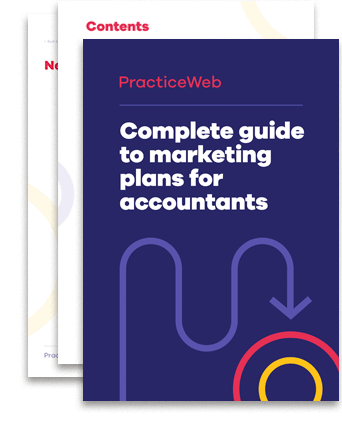Marketing plans for accountants
Structuring a marketing plan for your accountancy firm, aligning goals and managing your budget.
How to structure a marketing plan for your accountancy firm, align your business goals with marketing goals, manage your budget and calculate return on investment.
This guide draws on experience our team has developed during the 20 years PracticeWeb has been in business and the process we use ourselves in creating our own yearly marketing plan.
The eBook covers some of the areas you will need to address when putting together your practice’s marketing plan for the year ahead, including:
- Defining your purpose and finding your niche.
- Structuring a marketing plan document.
- The ideal customer – buyer personas.
- Aligning business goals with marketing goals.
- Turning the plan into a concrete document.
- Stakeholder management.
- Bidding for and managing your budget.
- Calculating return on investment.
PracticeWeb offer accountancy firms the most comprehensive range of marketing packages available.
Download the eBook
Sample: The complete guide to marketing plans for accountants
This guide was created by the PracticeWeb team with input from Alex Tucker, Ray Newman and Philippa Jordan.
Introduction
We all know how pressed for time accountants are, and not every partner or director of an accountancy practice is willing to commit resources towards a marketing plan without having a guarantee of return on investment.
First, for clarity:
a marketing strategy is a statement of what you want to achieve in the long-term
while a marketing plan sets out what you’re going to do to get there in the next six- or twelve-month period.
A good marketing plan focuses time, energy and budget on what matters most, with business goals in mind. It maintains momentum and provides clarity about who needs to do what, by when, and why.
The marketing plan should be a concrete document – something you’ve debated and discussed with key stakeholders, that they’ve signed up to, and that anchors marketing activity from that point on.
In practice, that probably means one or more of the following:
- a paper written in something like Microsoft Word,
- a formal project plan using Gantt charts, swimlanes or similar,
- a spreadsheet.
Reviewing progress against the plan will ideally be a standing agenda item at team or board meetings, reminding everyone of the marketing goals and the contribution they have to make.
Defining your purpose and finding your niche
Before you can put together a plan you need to be really clear about what you want to achieve – what’s your strategy?
A clear statement of that should be (either figuratively or literally) the first page of your marketing plan.
If you’ve already defined a business plan, you can probably take a shortcut here.
A quick note: sometimes goals come first, then a defined proposition.
In our experience, it’s usually the other way round, however, which is reflected below.
First, research and reflect upon the state of the market, the competition and where there are opportunities for your accountancy practice to develop a unique proposition: what can you do better than any other accounting firm?
Typically, when the conversation turns to market niches, people start to think of industry sectors and that is one sound way to approach it.
Try to keep an open mind, though – it might be that your niche has more
to do with, for example:
- where potential clients are geographically
- the stage of life they’re at
- the size of their business
- their sensitivity to price.
Next, think about what you want to achieve by defining specific, measurable business objectives or business goals.
At this point, people often shout ‘Profit!’ and, yes, that’s what most businesses are seeking to achieve. We’re talking here about the next level of detail down – profit how?
Here are some examples:
- Sign up 10 new construction industry clients each month.
- Increase the average revenue per client to £850 per month by the end of the year.
- Achieve £1.5 million in fees in 2021/22.
- Get 20% of existing clients signed up for business advisory services.
Once you’ve defined strategy, goals and a niche, you can start thinking about who you’re trying to reach.
The ideal customer: buyer personas
Buyer personas are a key part of your marketing strategy but you should also refer to them when putting together and implementing your practical marketing plan.
Software engineer Alan Cooper is generally credited with having invented the concept of what were then called ‘user personas’ in 1983.
His big idea was that focusing on the needs of a single imagined end user would produce better results than trying to turn out products that did all things for all people.
Today, buyer personas (or customer personas as they’re sometimes called) are often used to give marketing activity a clear target.
It would be worth taking time to read our Complete Guide to Buyer Personas if you haven’t already done so.
Our eBook contains a handy printable template we created to help you define your persona.
Defining a buyer journey for your personas is also helpful: as they go from awareness of your firm to making a final decision to purchase, what’s going through their mind?
Next, it’s down to the practicalities of putting a plan together.
When are you going to do it and what should it include?
When to work on your marketing plan
Timing your planning cycle correctly can help you to produce a marketing plan effectively and with minimum impact on the core of your role.
You might find that it’s best for the planning cycle to coincide with or follow financial year-end so you can reflect on your marketing and financial objectives at the same time and make sure they match up.
If you need to get sign-off from partners or other stakeholders in your practice, make sure you factor this into your planning cycle.
Make sure any deliverables are set out in a shared calendar or schedule.
With a solid, comprehensive plan in place by, say, the end of April, maintaining it will be much easier.
Schedule regular reviews and progress updates throughout the year.
Perhaps most importantly, your marketing efforts should complement your clients’ priorities and activities.
Stakeholder management
Stakeholders are people who have something to gain from the success of your accountancy firm’s marketing plan.
Ideally, they’ll not only help shape it but also offer support and guidance during its implementation.
First, though, you need to work out who owns your marketing plan and is ultimately responsible for its success.
This will depend on a number of factors including the size of your accountancy practice and its level of commitment to marketing.
Although it can be helpful to have creative minds in the room when drawing up a plan, it’s not absolutely necessary for the owner to be a marketing person.
They just need to know the business and its clients and, of course, be convinced of the value of marketing.
You might then make up the rest of the marketing committee with partners and investors, or – a really smart move – more junior members of the team.
Other stakeholders might be key clients who, though you don’t involve them directly in managing the marketing plan, you will want to have in mind when designing and reviewing it.
You might consider getting their input informally through requests for feedback or just over a coffee if the opportunity arises.
Investors and lenders are also stakeholders and might ask to see your marketing plan before deciding to put more money into your firm to fund growth.
Structuring your marketing plan
It’s useful to follow a set structure for this kind of business documentation because it makes it easier for stakeholders and investors to find the information they’re looking for.
A good marketing plan will include some or all of the following:
1. SWOT analysis
A SWOT analysis is a useful tool for understanding your market position as it stands right now.
Think specifically about the next period:
- Are changes to the rules around off-payroll working going to affect your firm, for example?
- Are you planning an office move?
- What might be in the Spring Budget that your clients and prospects might want support in dealing with?
The insight you gain here will be invaluable when it comes to identifying opportunities and avoiding problems.
Our eBook contains a useful SWOT analysis template from the ACCA to download.
2. PESTLE analysis
A PESTLE analysis is a method for identifying and evaluating the external factors that play a bigger role in shaping your company’s sector of the market and its chances of business success from these.
The PESTLE analysis will allow you to have a deeper understanding of possible threats to your business in the upcoming year and also in the marketing activity that you may choose to invest in.
3. Marketing goals
Marketing goals should draw upon your business goals – but don’t just copy and paste them.
Marketing goals might include:
- how you want your business to be perceived
- how many leads you need to generate to meet your growth goal
- the audiences you want to reach.
Try to make your marketing goals SMART (specific, measurable, achievable and realistic).
4. Growth areas
Once high-level goals have been set, start thinking about where desired growth is going to come from.
Go back to your SWOT analysis and map growth areas in your marketing objectives against your strengths and opportunities.
The idea is to market the things you do best to the people who most need your help.
5. Capability assessment
This is about sense-checking your firm’s ambitions against its ability to deliver services. You’ll want to answer the following questions:
- What services do you currently offer?
- Are your clients aware of the full range?
- In which areas do you have the most expertise?
- Do you have the sales and delivery to fulfill your growth plans?
- If you achieve the desired level of growth, will you need to recruit?
6. Customer definition and research
This is a good place to remind everyone of the buyer personas you defined at the start of this exercise, along with the buyer journey and their pain points.
In particular, this is now the time to think about specifically how you’ll reach them – what kinds of content do you need to produce, and which channels are best?
You can record this in various ways but a content calendar can be especially effective, showing exactly which items of content will need to be delivered when, and by whom.
Market research
Market research doesn’t need to be costly or time consuming, and can even be done from the comfort of your own desk.
Before you undertake any research, though, make sure you’re clear about the questions you want to answer –
“If we launch a new business advisory service, will people expect it to be delivered face-to face?”
might be one example.
This will focus your efforts and prevent you from getting overwhelmed and distracted by too much information…….
Download your copy to read further sections on:
- Messaging
- Value positioning and content strategy statements
- Tactics and scheduling which includes a free marketing plan template that can be downloaded
- Key Performance indicators (KPIs) to measure progress against planned marketing activity
- Tracking tools to help with measuring.




